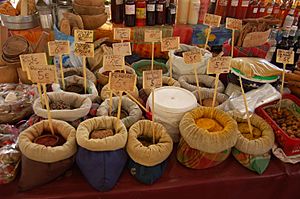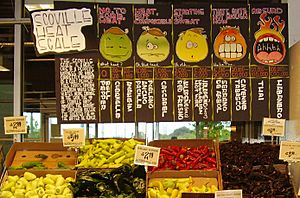Pungency facts for kids
Pungency is a word that describes the "spicy" or "hot" feeling you get from certain foods. Think of the strong kick from chili peppers! This feeling is also called hotness or heat. Sometimes, if a food is only a little bit spicy, but in a nice way, we call it piquancy. Foods like mustard and curry can be piquant.
Contents
What Do These Words Mean?
When scientists talk about "pungency," they mean that specific "hot" feeling from things like chili peppers. They use this word to be clear, because "hot" can also mean something is warm in temperature, and "spicy" can mean it has lots of spices.
For example, a pumpkin pie can be hot if it just came out of the oven. It can also be spicy because it has spices like cinnamon and cloves. But it's not pungent because it doesn't have that chili pepper heat. On the other hand, pure capsaicin (the chemical that makes chilies hot) is very pungent, even though it's not hot in temperature and has no other spices.
The word "piquancy" often means a milder kind of spiciness. It describes flavors that are "agreeably stimulating to the palate." This means they are pleasant and make your mouth feel lively. So, pungency is usually for very strong heat, while piquancy can be for any food that is nicely spiced.
If a food is mildly pungent or a bit sour, you might call it tangy.
Where We Find Pungency
Pungent substances are used in many ways. They can be used to flavor foods and sometimes even as pain relievers.
Pungency in Foods

The spiciness of foods is often measured. For chili peppers, we use the Scoville scale. This scale tells us how much capsaicin (the chemical that causes the heat) is in a pepper. The more capsaicin, the higher the Scoville rating, and the hotter the pepper!
It's interesting to know that pungency isn't really a "taste" like sweet or sour. Instead, it's a feeling! When you eat something pungent, special nerves in your mouth send signals to your brain. These signals make you feel a sensation of heat or burning. This is why you can feel the heat of a chili pepper in other parts of your body too, like your nose or even a small cut, even though those areas don't have taste buds.
The hot sensation from chili peppers, black pepper, ginger, and horseradish is super important in many foods around the world. You'll find spicy dishes in Korean, Indian, Mexican, Thai, and many other cuisines.
How We Feel the Heat
We feel pungency through something called chemesthesis. This is how our skin and the wet linings inside our bodies (like in our mouth) react to certain chemicals. Chemicals like capsaicin can make you feel a burning or tingling sensation. This happens because they activate special sensors in your body that normally detect heat or pain.
Scientists think that the spiciness in chilies might be a way for the plants to protect themselves from tiny germs.
See also
 In Spanish: Pungencia para niños
In Spanish: Pungencia para niños


